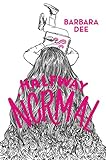Halfway normal
Series: A junior library guild selection ; 0917Publication details: New York : Aladdin, 2017Edition: 1. Aladdin hardcover editionDescription: 247 numbered pages ; 22 cm x 14 cmISBN: 9781481478519 (hardback)Subject(s): Child with cancer | Family experiencing cancer | Hair loss: child | Hospital experience | Recovery | Leukaemia | Recovery | Friendship | SchoolOther classification: 83 Summary: Twelve-year-old cancer survivor Norah struggles to fit in at middle school after two years of treatment for leukaemia, but she finds her voice with the help of new friend Griffin, who shares her love of mythology. Her story charts the ups and downs of navigating normal life after such a long absence. During this time, friendships and alliances have been reconfigured, as has her home life: her divorced parents have been compelled into an awkward domestic arrangement to care for their daughter. Norah strains against what she regards as excessive parental restrictions on her social life, prompted by their anxiety regarding her compromised immunity. There is plenty of humour in this book, interwoven with the frustration of being defined as “the girl who...” with the significant omission of the word “cancer”, which most people are at pains to avoid. In fact, Norah and her father have personified her cancer as various invented characters, such as Luke Emia, “a sci-fi warlord with a battalion of white blood cell storm troopers. Or Low-Key Mia, who sapped your energy and kept it in a jar in her evil lab”. Norah has been moved up a year for two subjects, as she excelled at them while being home tutored during her treatment, and being in these classes with older students makes her uncomfortably aware of the physical toll cancer and chemotherapy have wrought on her body. Norah’s short hair and under-developed body cause her to be mistaken for a boy, and on her first day back at school she regrets wearing an orange T-shirt which makes her look “like a Cheeto in a hazmat suit”. To reclaim her femininity, and rejecting her parents’ curtailment of her agency, Norah gets her ears pierced so that she can wear dramatic, feminine earrings. This book will appeal to young teens who are chafing against parental authority, dealing with school, families and friendships, and trying to establish their own identity even without the additional burden of having so recently overcome a potentially fatal illness. It will also appeal to younger readers. It is warm, honest, funny, and ultimately hopeful. Novel. Audience: Child 10 - 14| Item type | Current library | Collection | Call number | Status | Date due | Barcode | |
|---|---|---|---|---|---|---|---|
 Book
Book
|
Mercy University Hospital Psycho-oncology | Child | Available | 39117000000192 |
Originaludgave: 2017
Twelve-year-old cancer survivor Norah struggles to fit in at middle school after two years of treatment for leukaemia, but she finds her voice with the help of new friend Griffin, who shares her love of mythology. Her story charts the ups and downs of navigating normal life after such a long absence. During this time, friendships and alliances have been reconfigured, as has her home life: her divorced parents have been compelled into an awkward domestic arrangement to care for their daughter. Norah strains against what she regards as excessive parental restrictions on her social life, prompted by their anxiety regarding her compromised immunity.
There is plenty of humour in this book, interwoven with the frustration of being defined as “the girl who...” with the significant omission of the word “cancer”, which most people are at pains to avoid. In fact, Norah and her father have personified her cancer as various invented characters, such as Luke Emia, “a sci-fi warlord with a battalion of white blood cell storm troopers. Or Low-Key Mia, who sapped your energy and kept it in a jar in her evil lab”. Norah has been moved up a year for two subjects, as she excelled at them while being home tutored during her treatment, and being in these classes with older students makes her uncomfortably aware of the physical toll cancer and chemotherapy have wrought on her body. Norah’s short hair and under-developed body cause her to be mistaken for a boy, and on her first day back at school she regrets wearing an orange T-shirt which makes her look “like a Cheeto in a hazmat suit”. To reclaim her femininity, and rejecting her parents’ curtailment of her agency, Norah gets her ears pierced so that she can wear dramatic, feminine earrings.
This book will appeal to young teens who are chafing against parental authority, dealing with school, families and friendships, and trying to establish their own identity even without the additional burden of having so recently overcome a potentially fatal illness. It will also appeal to younger readers. It is warm, honest, funny, and ultimately hopeful. Novel.
Audience: Child 10 - 14
There are no comments on this title.
